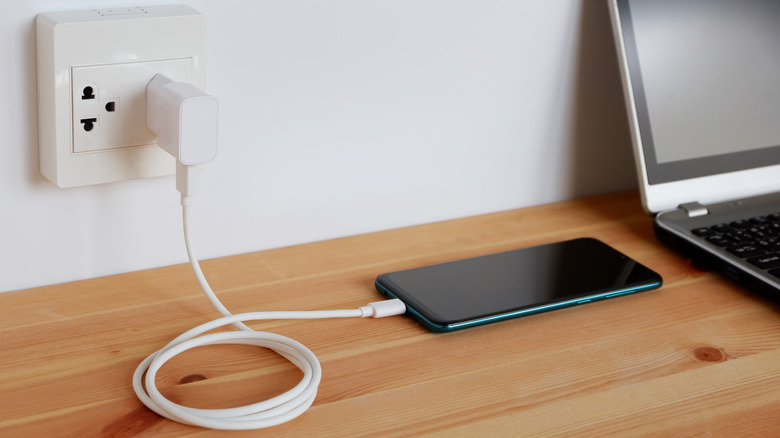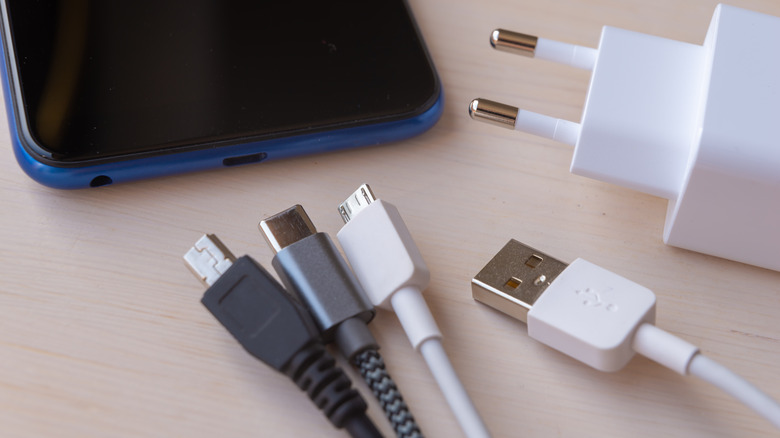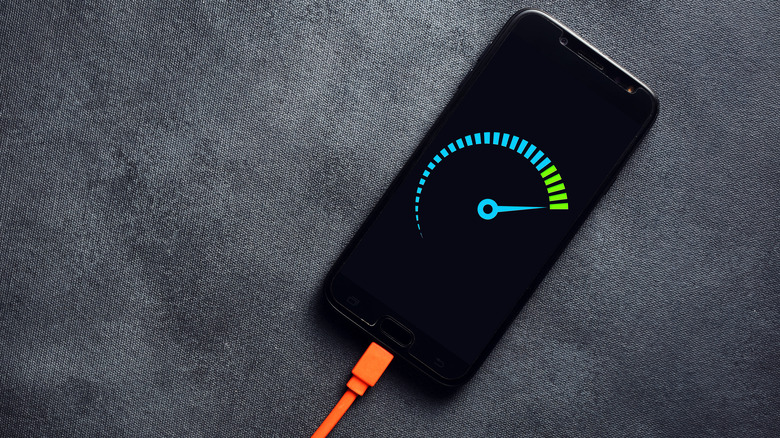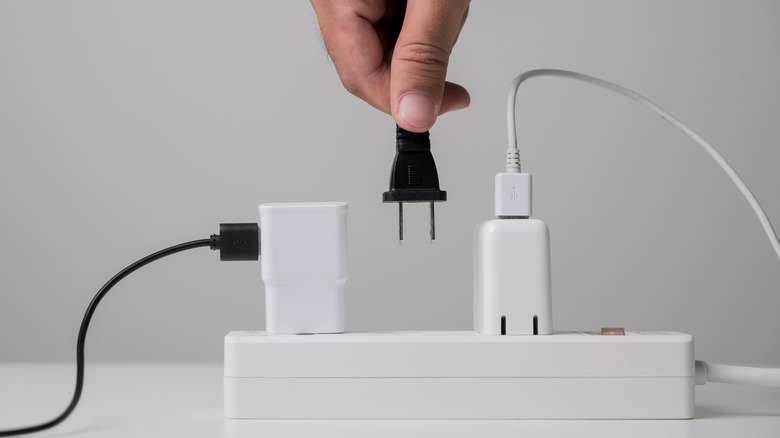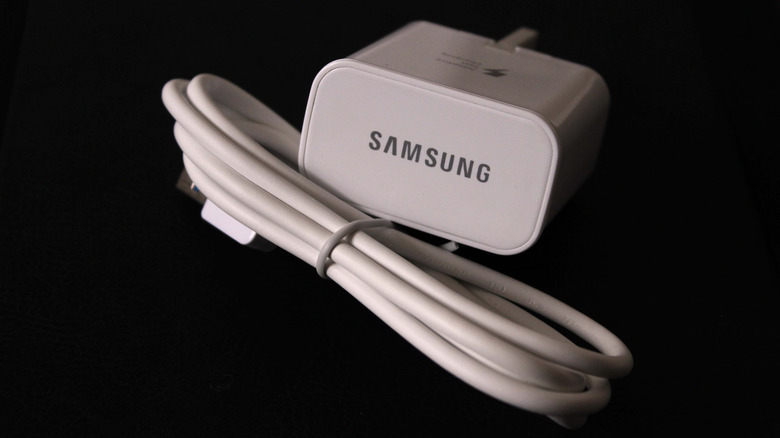Why You Need To Use The Right Charger For Your Android Phone
We may receive a commission on purchases made from links.
While we make a lot of effort in selecting the best Android phone, we hardly think about getting the right charger. Many people simply accept the available charger or order a cheap third-party adapter online when buying a smartphone. Consumers might think that selecting a charger has minimum to no role in how a phone performs when, in fact, using the wrong power adapter with your smartphone not only extends the charging time but can also damage the battery that powers your phone. Especially now, many smartphone brands do not provide a charger in the box with the phone. Hence, it is vital to do some research and select an appropriate charger for your precious Android smartphone.
Back in 2020, Apple stopped providing a power adapter with iPhones. While Android phone manufacturers such as Samsung made fun of Apple, many followed suit. Since 2021, companies like Samsung and Google have shipped smartphones without a free adapter. Nevertheless, it doesn't matter whether you're buying a new smartphone or need a charger for your old device; you need a basic idea about the factors determining which charger will complement your device.
Different Android smartphones support different charging standards
USB stands for Universal Serial Bus. It is the global standard that sets specifications and protocols for connectors, cables, and how they communicate with other devices. Everyone has used some form of a USB port at one time or another. For instance, the port on your laptop that lets you connect an external keyboard, mouse, or flash drive is a USB Type-A port. Then there are other types, such as micro USB and USB Type-C. While older Android phones use micro USB, most modern smartphones come with a USC-C connector. The main difference between these ports is the charging standards they follow.
Broadly speaking, Android smartphones support either of the two charging standards: USB PD and OEM-specific or proprietary. The Universal Serial Bus Power Delivery (USB PD) standard has been around for about 10 years and works with USB-C ports. It supports up to 240W of power, making it ideal for several devices such as laptops, tablets, power banks, and more (via USB.org). Further, the high power delivering capacity allows manufacturers to configure according to their needs with enough headroom.
On the other hand, several companies like Oppo and OnePlus have developed proprietary charging standards that utilize the Type-C port. While these standards support fast charging, they are device-specific. For example, the Samsung Galaxy S22 Ultra comes with Super Fast Charging, a standard compliant with USB standards.
It is easy to get a third-party charger for a USB PD phone
The thing about proprietary standards is that they work with chargers and cables manufactured by the company (via GSMArena). Take OnePlus' SuperVOOC charging as an example. It only works with the company's phones and compatible accessories. Proprietary charging also helps companies earn extra cash, especially those selling accessories separately. Another popular proprietary charging standard is Qualcomm Quick Charge, which works with most smartphones powered by Snapdragon chipsets. In contrast, USB PD is among the most common charging protocols supported by Android phones, laptops, and other gadgets.
The charging standard followed by a manufacturer also affects the total time your Android phone will take to charge. Since USB PD allows up to 240W of power, manufacturers can tweak the voltage and current combination per their smartphones' battery and enable fast charging. To check the charging standard supported by your smartphone, you should refer to the official spec sheet released by the company. Another important detail you should take into consideration is the maximum charging rate your smartphone supports.
The charging standard and the maximum charging rate of your smartphone are the factors you should consider while purchasing a third-party charger, a car charger, or even a power bank. It will not be challenging to look for these details as companies that sell power adapters mention them outright. For instance, the Anker PowerPort III supports USB PD PPS, Qualcomm Quick Charge 4+, and can provide a maximum output of 25W, depending on which adapter you choose.
The right charger offers optimum speed
Let's assume you wish to purchase a charger for the Google Pixel 6a. On the official website, Google mentions that the device is compatible with USB PD 3.0 PPS adaptors and supports wired charging up to 18W. Hence, if you wish to purchase a third-party charger, you should ensure it complies with the USB PD 3.0 PPS standard. Even if it has a higher rating, the programmable power supply should only charge the battery at 18W. However, a charger rated less than 18W will increase the charging time. This is also true for other Android smartphones and is why some chargers take longer to recharge your phone than others.
On the other hand, you may own a smartphone that supports proprietary charging, such as the OnePlus 9R with its support for the Warp Charge protocol. The Warp Charge protocol is based on Oppo's Voltage Open Multi-Step Constant-Current Charging system, abbreviated as VOOC, which does not work with smartphones from other manufacturers. Suppose the power adapter you get with the OnePlus 9R stops working; you will have to purchase another adapter from the company as it is tough to find a third-party wall charger that supports the Warp Charge protocol.
If you get a non-compliant charger for either of the phones (that supports USB PD or proprietary charging), it won't charge your phone in the advertised time — in fact, in some cases, it might not be able to charge your phone at all. In the worst-case scenario, you might end up harming your phone's battery.
Go with the charger recommended by the company
Given that taking care of so many things might not be possible for everyone, purchasing the charger recommended or made by the company that made your phone is a viable option. This will ensure that your smartphone and the power adapter support the same charging standard. Companies might have a monetary benefit behind selling a charger, but it is the safest bet.
To understand, assume you wish to purchase a charger for the Samsung Galaxy S22 Ultra, which supports up to 45W wired charging (via Samsung). Instead of searching for third-party options that support Super Fast Charging (proprietary standard) and being unsure about your choice, go with a charger made by the company — in this case, the 45W USB-C Fast Charging Wall Charger by Samsung should be your go-to pick. If you wish to power more than one device at a time, you can get the 65W Trio Adapter.
Other companies like Google, Xiaomi, OnePlus, and Motorola also sell chargers for their smartphones. Ultimately, using the right charger for your Android phone not only saves you time, but also saves you money in the long run.
